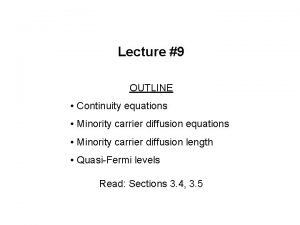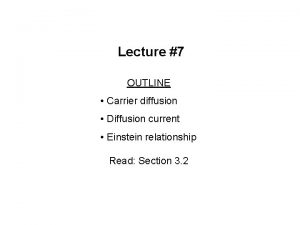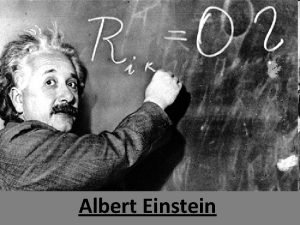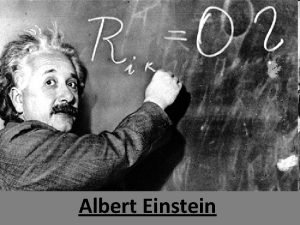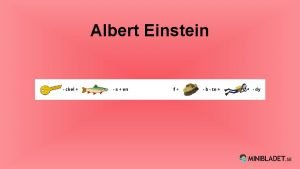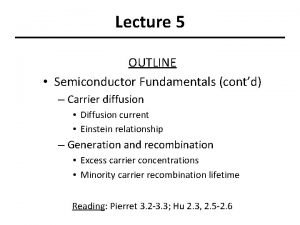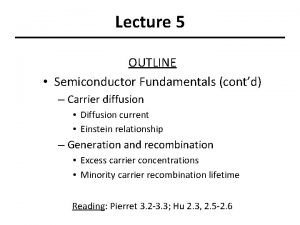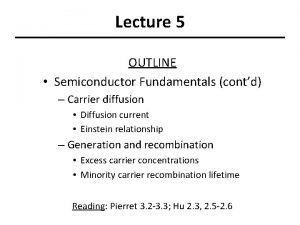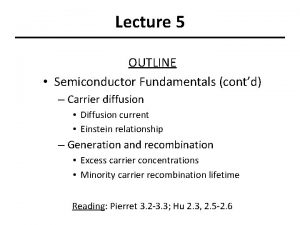Lecture 7 OUTLINE Carrier diffusion Diffusion current Einstein













- Slides: 13

Lecture #7 OUTLINE • Carrier diffusion • Diffusion current • Einstein relationship • Generation and recombination Read: Sections 3. 2, 3. 3

Diffusion Particles diffuse from regions of higher concentration to regions of lower concentration region, due to random thermal motion. 2 Spring 2007 EE 130 Lecture 7, Slide 2

1 -D Diffusion Example • Thermal motion causes particles to move into an adjacent compartment every t seconds – Each particle has an equal probability of jumping to the left and to the right. 3 Spring 2007 EE 130 Lecture 7, Slide 3

Diffusion Current x x D is the diffusion constant, or diffusivity. 4 Spring 2007 EE 130 Lecture 7, Slide 4

Total Current J = JN + JP e+ JN = JN, drift + JN, diff = qn n e– JP = JP, drift + JP, diff = qp p 5 Spring 2007 EE 130 Lecture 7, Slide 5

Non-Uniformly-Doped Semiconductor • The position of EF relative to the band edges is determined by the carrier concentrations, which is determined by the dopant concentrations. • In equilibrium, EF is constant; therefore, the band energies vary with position: Ec(x) EF Ev(x) 6 Spring 2007 EE 130 Lecture 7, Slide 6

• In equilibrium, there is no net flow of electrons or holes JN = 0 and JP = 0 The drift and diffusion current components must balance each other exactly. (A built-in electric field exists, such that the drift current exactly cancels out the diffusion current due to the concentration gradient. ) dn = + =0 e J N qn n q. DN dx 7 Spring 2007 EE 130 Lecture 7, Slide 7

Consider a piece of a non-uniformly doped semiconductor: Ec(x) EF =Ev(x) n qe k. T 8 Spring 2007 EE 130 Lecture 7, Slide 8

Einstein Relationship between D and m Under equilibrium conditions, JN = 0 and JP = 0 J N = qn ne + q. DN 0 = qn n e - qn dn =0 dx q. DN e k. T Similarly, Note: The Einstein relationship is valid for a non-degenerate semiconductor, even under non-equilibrium conditions 9 Spring 2007 EE 130 Lecture 7, Slide 9

Example: Diffusion Constant What is the hole diffusion constant in a sample of silicon with p = 410 cm 2 / V s ? Solution: Remember: k. T/q = 26 m. V at room temperature. 10 Spring 2007 EE 130 Lecture 7, Slide 10

Potential Difference due to n(x), p(x) • The ratio of carrier densities (n, p) at two points depends exponentially on the potential difference between these points: 11 Spring 2007 EE 130 Lecture 7, Slide 11

Quasi-Neutrality Approximation • If the dopant concentration profile varies gradually with position, then the majority-carrier concentration distribution does not differ much from the dopant concentration distribution. – n-type material: – p-type material: ® in n-type material 12 Spring 2007 EE 130 Lecture 7, Slide 12

Summary • Electron/hole concentration gradient diffusion • Current flowing in a semiconductor is comprised of drift & diffusion components for electrons & holes – In equilibrium, JN = JN, drift + JN, diff = 0 J = JN, drift + JN, diff + JP, drift + JP, diff • The characteristic constants of drift and diffusion are related: 13 Spring 2007 EE 130 Lecture 7, Slide 13
 Drift current and diffusion current in semiconductor
Drift current and diffusion current in semiconductor Drift current
Drift current Drift current and diffusion current in semiconductor
Drift current and diffusion current in semiconductor Diffusion current formula
Diffusion current formula Continuity equation in semiconductor
Continuity equation in semiconductor 01:640:244 lecture notes - lecture 15: plat, idah, farad
01:640:244 lecture notes - lecture 15: plat, idah, farad Swabt
Swabt What is expansion diffusion
What is expansion diffusion Lecture outline example
Lecture outline example Lecture outline example
Lecture outline example Lecture outline example
Lecture outline example Lecture outline meaning
Lecture outline meaning A balanced delta connected load having an impedance 20-j15
A balanced delta connected load having an impedance 20-j15 Phase to phase voltage
Phase to phase voltage




